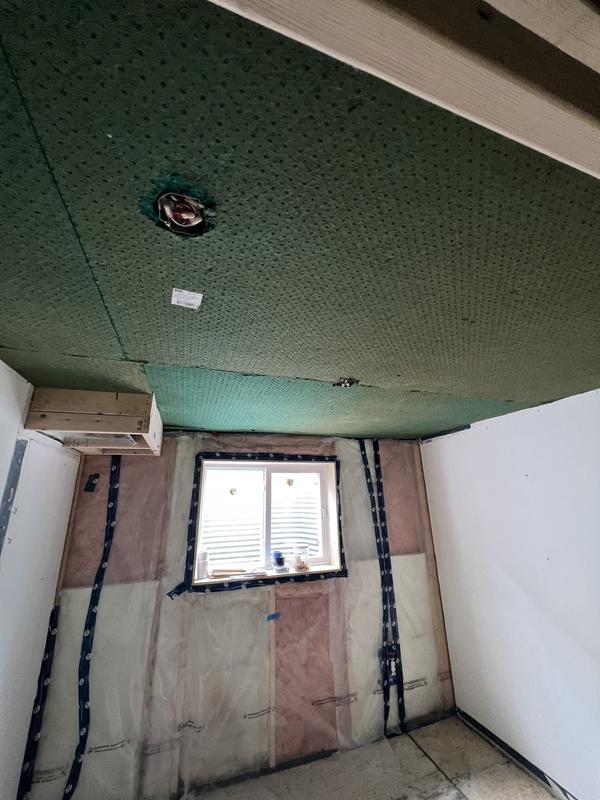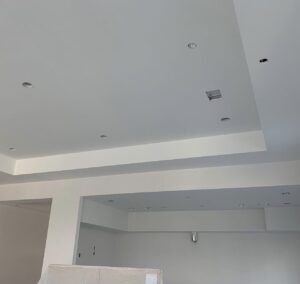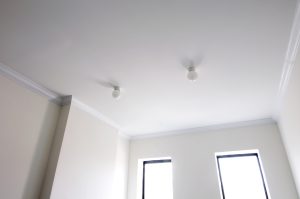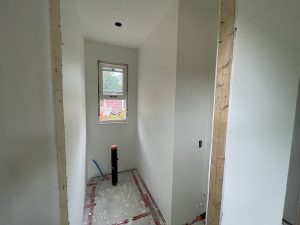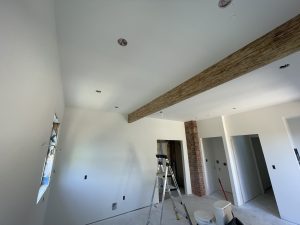With open-concept designs, remote workspaces, and urban living on the rise, noise control has become a key consideration in modern homes. Soundproofing with drywall is an effective and popular way to minimize unwanted noise, ensuring comfort and privacy within the home. Today’s drywall innovations offer more than just standard soundproofing—they’re designed for high efficiency, space-saving, and even aesthetic appeal, making them suitable for any room in a modern residence.
In this article, we’ll explore the latest advancements in soundproofing drywall, covering materials, techniques, and installation options to help you find the perfect solution for a quieter, more serene home.
1. Understanding the Basics of Soundproofing in Drywall
Soundproofing drywall primarily aims to reduce sound transmission between spaces. Sound travels in waves, and when those waves hit a surface, they either reflect back, are absorbed, or pass through to the other side. The key to soundproofing drywall lies in using materials and construction techniques that break up or dampen these waves, which reduces their transmission through walls.
There are two main types of noise to control in a home environment:
- Airborne Noise: Sounds carried through the air, such as voices, music, or television.
- Impact Noise: Sounds resulting from direct impacts on walls, floors, or ceilings, such as footsteps or dropped objects.
Advanced soundproofing drywall solutions are designed to tackle both of these types of noise, creating a quieter living space for every member of the household.
2. Multi-Layered Drywall: Enhanced Noise Reduction
Multi-layered drywall, also known as double-layer drywall, consists of two or more layers bonded together to create a thicker, more effective sound barrier. This configuration increases the mass of the wall, which helps to reduce sound transmission significantly. By using multiple layers, sound waves are broken up as they move through the wall, providing superior sound control.
This type of drywall is an excellent choice for high-noise areas, such as:
- Home theaters or media rooms: Where sound needs to be contained within a room.
- Bedrooms and bathrooms: Where privacy is a priority.
- Apartments and condos: Multi-layered drywall works well for shared walls in multi-family housing.
Key Benefits:
- High STC Rating: Multi-layered drywall typically has a high Sound Transmission Class (STC) rating, indicating its ability to block sound effectively.
- Space-Saving: While thicker than standard drywall, multi-layered drywall is often thinner than other noise-reduction options, providing high soundproofing efficiency without taking up much space.
3. Sound-Damping Compounds for Enhanced Noise Reduction
Sound-damping compounds, such as Green Glue, are increasingly popular for soundproofing projects. These compounds are applied between drywall layers, where they act to absorb sound vibrations. By reducing vibrations, sound-damping compounds prevent noise from passing through walls, floors, and ceilings. They’re particularly effective in improving sound insulation when you’re working with existing drywall that you want to retrofit for soundproofing.
Common Applications of Sound-Damping Compounds:
- Home offices: Ideal for reducing noise transmission in work-from-home spaces.
- Family rooms or playrooms: Helps to manage sound from children’s play areas or high-traffic family rooms.
- Bedrooms and bathrooms: Offers an extra layer of sound privacy without thickening walls excessively.
Key Benefits:
- Affordable and Effective: Sound-damping compounds offer excellent soundproofing at a relatively low cost, making them ideal for budget-conscious homeowners.
- Flexible Installation: Can be applied in various areas, making it a versatile option for homeowners who want to upgrade soundproofing without complete renovation.
4. Enhanced Drywall Panels: High-Density Noise Control
Enhanced drywall panels, such as those by brands like QuietRock, integrate dense materials like gypsum and specialized composites, which naturally block sound transmission. These panels are created to have a high STC rating, effectively preventing airborne noise from traveling through walls and ceilings. They’re often used in rooms where high sound control is needed but adding multiple drywall layers is not feasible due to space limitations.
Ideal Uses for Enhanced Drywall Panels:
- Bedrooms and home offices: Enhanced drywall can ensure privacy in spaces where quiet is essential.
- Shared walls in condos or townhouses: Great for urban dwellings where neighboring noise can be a concern.
- Home theaters: Ideal for media rooms where sound control is necessary for a true cinematic experience.
Key Benefits:
- Space-Efficient: Maintains a thin profile, making it an excellent choice for tight spaces.
- High Sound Absorption: Excellent for preventing airborne noise, making it ideal for reducing unwanted sounds from adjacent rooms.
5. Resilient Channels: Innovative Installation for Soundproofing
Resilient channels, also known as flexible channels, are metal brackets installed between the drywall and the wall framing. These channels act as a buffer, preventing sound vibrations from easily transferring from the drywall to the studs and vice versa. This separation reduces sound transmission significantly, as it “decouples” the drywall, stopping sound vibrations in their tracks.
Flexible channels are especially beneficial in spaces where structural noise isolation is required, such as:
- Apartments and condos: Great for creating sound barriers in shared walls.
- Home studios or offices: Perfect for reducing external noise for professionals who work from home.
- Multi-story homes: Ideal for soundproofing ceilings between floors.
Key Benefits:
- Improves Sound Isolation: Resilient channels help break the path of sound, making them highly effective for noise control.
- Cost-Effective: Offers a less expensive solution for soundproofing without needing thick walls or multiple layers.
6. Acoustic Drywall with Built-In Absorptive Materials
Acoustic drywall is engineered with materials that absorb sound instead of reflecting it. This drywall type includes high-density gypsum combined with absorptive materials, such as mineral fibers and fiberglass, designed to dampen sound vibrations. Acoustic drywall is ideal for large homes where different floors or rooms connect closely, helping to prevent sound transmission between stories.
Applications for Acoustic Drywall:
- Multi-story homes: Great for homes where soundproofing between levels is essential, such as between bedrooms and living spaces.
- Home gyms or studios: Effective in absorbing sound from high-impact areas like home gyms or dance studios.
- Bathrooms and kitchens: Acoustic drywall that’s moisture-resistant works well in areas prone to humidity while offering soundproofing.
Key Benefits:
- High Sound Absorption: Acoustic drywall dampens both airborne and impact noise, making it versatile for different noise control needs.
- Moisture-Resistant Options Available: Suitable for bathrooms, kitchens, and other spaces where sound control and durability are equally important.
7. Magnetic Drywall Systems for Advanced Soundproofing
Magnetic drywall systems are an emerging technology in soundproofing, featuring layers of magnetically charged drywall that attract and hold sound-dampening particles. These particles work to block sound more effectively than traditional drywall. Although still new, magnetic drywall shows promise as a high-end solution for homeowners seeking premium noise control.
Applications for Magnetic Drywall:
- Luxury homes: Appeals to tech-savvy homeowners and those looking for top-tier soundproofing.
- Home theaters: Great for ensuring an immersive entertainment experience.
- Shared walls in multi-family buildings: Helps minimize noise transfer in high-density living spaces.
Key Benefits:
- High Soundproofing Capability: Magnetic drywall layers are highly effective at preventing noise transmission.
- Cutting-Edge Technology: Ideal for homeowners looking to incorporate the latest innovations in home soundproofing.
Conclusion: Choosing the Right Soundproofing Drywall for Your Home
The latest soundproofing drywall innovations are transforming the way homeowners approach noise control. From multi-layered drywall and sound-damping compounds to flexible channels and acoustic panels, there are options for every type of home and budget. Whether you’re soundproofing for privacy, comfort, or a specific purpose like a home theater or office, these advanced solutions provide flexibility and effectiveness in creating a quieter, more comfortable environment.
With soundproofing drywall solutions now available for both DIY enthusiasts and professionals, homeowners can easily upgrade their living spaces without extensive renovations. As noise reduction continues to be a priority, exploring these cutting-edge options can make a significant difference in the quality of life in modern homes.
By investing in soundproofing drywall tailored to your unique needs, you can create a peaceful retreat within your home, free from the interruptions of unwanted noise.

